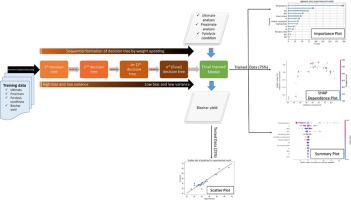Algal Research ( IF 4.6 ) Pub Date : 2020-07-15 , DOI: 10.1016/j.algal.2020.102006 Abhijeet Pathy , Saswat Meher , Balasubramanian P

|
Pyrolysis is a thermochemical pathway widely used for the conversion of biomass into useful products such as biochar, bio-oil, and syngases. A recent surge in the adoption of the pyrolysis process at realtime scenarios for the appropriate management and conversion of residues demands the modeling of the pyrolysis process. Prediction of algal biochar yield along with its composition was attempted in this study with the eXtreme Gradient Boosting (XGB) machine learning method. An extensive grid search method has been implemented in the XGB model to explore all the possible considered input parameter combinations for predicting the biochar yield. Thirteen different pyrolytically important input parameter combinations have been attempted and compared with the combination suggested by the feature selection technique of model for predicting the biochar yield. This feature selection technique highlights the H/C, N/C, ash content, pyrolysis temperature, and time as the key parameters on deciding the algal biochar yield, where H, C, N are hydrogen, carbon and nitrogen content of biomass. The highest regression coefficient (R2) of 0.84 has been achieved between experimental and model predictive biochar yield for the testing dataset, once the model was trained with the training dataset. Pearson correlation coefficient matrix unraveled the correlation among and in between input parameters and biochar yield. Feature Importance Plots revealed temperature as the most influential factor. SHapley Additive exPlanations (SHAP) Dependence Plots depicted the interactive effect of temperature and other input parameters on the algal biochar yield. Summary Plots showed the combined features of importance through feature and SHAP values. The developed XGB model provides new insights on comprehending the influence of input parameters on predicting the algal biochar yield.
中文翻译:

使用机器学习方法的eXtreme梯度增强(XGB)算法预测藻类生物炭产量
热解是一种热化学途径,广泛用于将生物质转化为有用的产品,例如生物炭,生物油和合成气。为了实时管理残留物并进行适当的管理和转换,在实时方案中采用热解过程的最新趋势要求对热解过程进行建模。在本研究中,尝试使用极限梯度增强(XGB)机器学习方法预测藻类生物炭产量及其组成。XGB模型中已实现了广泛的网格搜索方法,以探索所有可能考虑的输入参数组合,以预测生物炭的产量。已经尝试了13种不同的热解重要的输入参数组合,并将其与模型的特征选择技术建议的用于预测生物炭产量的组合进行了比较。此功能选择技术突出显示H / C,N / C,灰分,热解温度和时间作为决定藻类生物炭产量的关键参数,其中H,C,N为生物质的氢,碳和氮含量。最高回归系数(R一旦使用训练数据集对模型进行训练,就可以在测试数据集的实验和模型预测生物炭产量之间达到0.84的2)。皮尔森相关系数矩阵揭示了输入参数与生物炭产量之间以及之间的相关性。特征重要性图显示温度是影响最大的因素。SHapley Additive ExPlanations(SHAP)依赖性图描述了温度和其他输入参数对藻类生物炭产量的相互作用。摘要图通过要素和SHAP值显示了重要的组合要素。先进的XGB模型为理解输入参数对预测藻类生物炭产量的影响提供了新的见解。











































 京公网安备 11010802027423号
京公网安备 11010802027423号